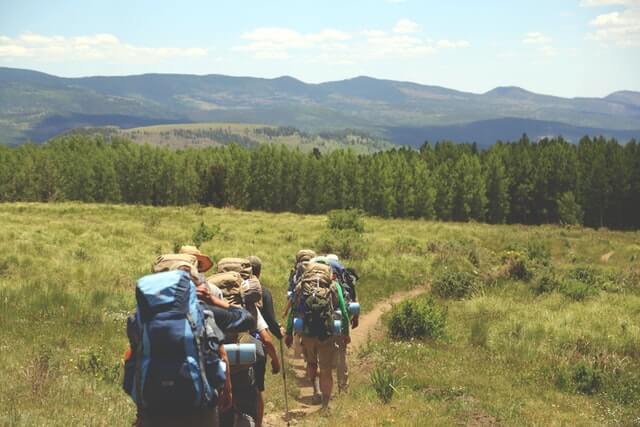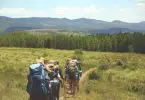Nowadays, outdoor activities – like hiking or camping – are getting more and more popular across the world. However, we believe that people should take into consideration how physically and mentally well prepared they are, and what to do to strengthen those aspects, to make those experiences more enjoyable.
For that reason, we decided to write about some useful tips on training for backpacking.
Why train before backpacking?
What would happen if you were to run a marathon next week and you started training today? Or even worse, what if you were to swim twenty-five miles in the ocean with no previous training? Unless you have super human abilities, you would probably quit before reaching your goal.
Well, you can consider that backpacking – in this case – is your marathon, since it is one those activities that are difficult for both, your body and your mind, and you can be a hundred percent sure that it would turn into an unpleasant and even dangerous activity if you don’t properly prepare yourself.
Must read: Which Exercises Help Prepare For Uphill Hiking? Your Guide To Blazing Trail
So, in here we show you a few reasons why you should always do a backpacking workout before a long expedition.
Slow down fatigue
Remember that every single action – singing, cooking and even walking – requires effort, and certainly, hiking is not the exception. During this activity, you might travel distances to which your body is not used to, while carrying a 15-pound sack on your back. For those who don’t exercise quite often, this is a very challenging thing to do.
So, in order to avoid stopping every fifteen minutes to rest and catch a breath, the best thing you can do is start training. It will enhance your cardio and muscular resistance, which will make you feel better along the trail.
More immersive experience
Let’s be honest, when we are performing an exhausting activity, all we want is to finish it and take a long break. The same happens when we are not in shape and try to make an extensive backpacking trip. We complain about how tired we feel, we think that we are not going to make it, and do not enjoy the journey at all.
Well, training before trips can be seen as a chain reaction because, when our physical condition is at the top and we feel good along the journey, we stop complaining about all those bad things we mentioned before. We actually start enjoying what nature has to offer – beautiful sights, freedom and peace.
It will help you complete longer trips
When you have a poor physical condition, a 40-mile journey could take you a week or more. But, what would happen if you wanted to go on a longer expedition? Do you actually have all that spare time?
Again, more of that chain reaction we were talking about. If you work out enough to build a strong and resistant body, you will be able to complete the expeditions faster, which will give you the opportunity to do longer trips in a relatively short amount of time.
It will make you look fabulous
In this article, we are supposed to talk about the benefits that training will bring you on upcoming backpacking expeditions. However, it is difficult not to mention that exercising your body will not only give you enough stamina to accomplish your hiking goals, but it will also make your muscles grow stronger and make you look wonderful.
What should you take into consideration?
As we stated before, backpacking is not easy since it is an activity that will test your physical and mental capacity. Therefore, there are a few aspects you should have in mind before and during the process of working out for your trips. Those are:
Visualize your goal and be realistic about it
One of the best things you can do to motivate yourself is to set an objective that will give you a purpose, and make you work hard to accomplish it.
However, if your goal is to walk more than thirty miles a day, you cannot expect that working out once a week for two months will be enough. Be realistic and prepare an exercise plan that meets your requirements and capacities.
Be consistent on your training and take enough time to succeed
It does not matter how many lunges, push-ups and squats you do, or miles you run, you will not see results right away. In fact, there is a quote that says “it takes four weeks for you to notice your body changing, eight weeks for your friends to notice and twelve weeks for the rest of the world to notice”.
Relating this quote to our topic, we could say that it takes twelve weeks for the trails to notice that your body is changing. For that reason, you have to make sure you give yourself enough time to get in shape and ultimately accomplish what you want.
Don’t forget about the backpack
Usually, those who are not used to hiking make a particular mistake. When training before a long expedition, people forget about wearing a backpack. It does not matter whether you are the cardio master; if you are not used to carrying twenty-something pounds on your back, your shoulders, hips and neck will be sore for the entire trip.
A good way to prepare your body is by walking long distances or even doing short hikes wearing the backpack you plan to use. This way, you will strengthen the muscles of your back and get used to the weight you will be carrying. See our tips on how to choose the best ultralight backpacks to give you more options.
However, it is important that you do not wear your backpack when doing resistance exercises – like planks, step ups or lunges – because it could be dangerous and produce back injuries.
Set a training schedule
Now that we have established how important it is to be prepared for long backpacking tours, it is time to organize your time. Create a schedule that shows the exercises you will do and be as detailed as you can.
Now, depending on the length of your trip and how fast you want to complete it, you should set the different types of exercises, their duration and the estimated time it will take you to do them to achieve your goal. However, we will list some exercises that will help you achieve the performance you are looking forward to get for your journeys.
The first thing we recommend you is to determine how much time you have to work out and how often you would be able to hike. Once you know this, you can start planning your exercise schedule.
Now, it is time for you to divide your routine focusing on three different set of activities that will enhance your cardio condition, your muscular resistance and your performance when hiking, altogether.
| First Activity | Second Activity | |
| Monday | Cardio Workout | Recovery time |
| Tuesday | Cardio Workout | Muscular Workout |
| Wednesday | Cardio Workout | Recovery time |
| Thursday | Cardio Workout | Muscular Workout |
| Friday | Recovery Time | Recovery time |
| Saturday | Short Cardio Workout | Short Hiking Session * |
| Sunday | Recovery time | Recovery time |
*If you are not used to hiking, it is recommended to start doing long walks instead of short training hikes on the first week.Now, it is time to talk about actual exercises. There are lots of routines that you could follow to strengthen your body; however, the following workout was specifically made to help backpackers prepare for their trips.
In this chart, we show you how to distribute the exercises to form a training plan. As you noticed, the first activity should always be acardio workout in order to properly warm up your body, which will prevent any type of injury.
As we stated before, every time you go for short hikes or long walks, you should take your backpack with you. At the beginning, you might feel that it is slowing your pace down, but that is the point. It would be better getting used to that extra weight from the very beginning, than realizing how difficult it is when you start a large backpacking trip.
Training routine
Before you start any kind of exercise, you have to warm up and stretch to avoid injuries. Once you finish it, start with this program.
Cardio Training
As you know, having a good cardio condition is the key to complete backpacking journeys. For this reason, you should really focus on doing it at least four times a week. Here is a list with a few exercises you could do.
Also, since we know that not everybody has a gym near home, we decided to make two different routines. The first one can be done at the gym, and the second one, at home.
At the gym
- Stair machine. For those who enjoy going to the gym, the stair machine is a good option. You will train your legs and butt while doing some cardio, as well. The best part of it is that you could mix some exercises up to add more intensity. Start climbing facing front at a comfortable speed for eight minutes. Then, turn sideways and work out that way during four minutes. After that, turn around and climb backwards for four more minutes, and finish with a fast four minute sprint. When you complete this set, rest for two minutes and go for the next exercise
- Cycling. It is a low impact exercise that targets your cardio condition and leg resistance (hiking is a low-impact exercise as well). You can work out between slow, medium, fast and maximum level intervals to mix it up a little bit. Start cycling slowly for five minutes to warm up. Then, switch to medium and to fast level for one minute each. Repeat four times, slow down for one minute and start over. Once you finish it, go for the maximum level for two minutes and conclude your training with slow cooling-down cycling.
At home
- Jogging. Jogging is one of the easiest and most common exercises you could do to strengthen your legs, your butt and lift your resistance. All you need is a pair of running shoes and hit the road. For this routine, start jogging at fifty percent of your capacity and hold it for four minutes, then take it to eighty percent and hold it for three minutes. Repeat this until you reach twenty-one minutes, and go to the next exercise.
- Jump rope, plank and push-ups routine. This might be hard if you don’t to work out too often, but it is a complete routine that will make your abs, arms, chest and legs work hard to give you the resistance you need to carry all that backpacking weight. To begin with, jump the rope for three minutes, then go for a plank for forty-five seconds and finish by doing push-ups for forty-five seconds, too. Repeat it four times.
Muscle Resistance Training
Since you will be walking a lot when you go hiking, it is imperative to train your legs. However, your core and upper body should be strong enough to handle the extra weight of the backpack.
For this reason, we compiled the following exercises and made a circuit that will build up your muscles.
At the gym
- Bulgarian Split Squat. To do it, you have to put a bench behind you, place one foot on it and the other one in front of you. Hold a lifting weight on each hand and bend down, doing a lunge. Repeat five times with using both legs, rest for a minute and move on to the next exercise. This one will toughen the muscles in your legs and arms at the same time. If you are not used to working out, do the exercises without the lifts to keep your balance, and to get used to the movements.
- High Box Step Up. You have to place one on a platform and move forward to get on top of it. By doing this, you will exercise your quadriceps, glutes and hamstrings. Do eight repetitions with each leg, rest for a minute and move on to the next exercise.
- Bosu Squat. Get on the rounded part of the Bosu and do a normal front squat. Place your hands in front of you to gain stability and always look front to avoid neck injuries. The Bosu adds instability and, if you squat slowly, you will strengthen your butt, quadriceps and core. Do twelve repetitions, rest for a minute and start the next exercise.
- Goblet Squat. Take a kettle bell and place it in front of your chest, do a squat and repeat it twelve times. This exercise will strengthen your upper and lower muscles, and will certainly give your body resistance for backpacking.
At home
- Leg and Core Power. Start with a plank and hold it for one minute, then take one knee to your chest and put it back to the floor. Do the same with the other leg and repeat the process for one minute. Now, bring both legs in and out trying to touch your chest with your knees, and go back to the plank position. Perform this routine for one minute and finally, do some squats for another one. Don’t forget to rest so you can continue with the next circuit.
- Chest and Arm Power. Going up and down slowly, make one minute of regular push-ups.
Then, work out your triceps by placing a chair behind you, putting your hands on it and going down slowly.
Finish this circuit with one minute of clap push-ups. Once you complete this, rest for four minutes and repeat both circuits three times.
It is important to cool-down and to stretch every time you finish with your daily routine.
Training schedules samples
| At the gym | 10 minutes | 20 minutes each exercise | 10 minutes | |||
| Monday | Warm Up | Stair Machine Training | Cycling | Stretch | Recovery Time | Recovery Time |
| Tuesday | Warm Up | Cycling | Stair Machine Training | Bulgarian Split Squat. | High Box Step Up | Stretch |
| Wednesday | Warm Up | Stair Machine Training | Cycling | Stretch | Recovery Time | Recovery Time |
| Thursday | Warm Up | Cycling | Stair Machine Training | Bosu Squats | Goblet Squat | Stretch |
| Friday | Recovery Time | |||||
| Saturday | Warm Up | Jogging | Short Hiking Session | Stretch | ||
| Sunday | Recovery Time |
| At home | 10 minutes | 20 minutes each exercise | 10 minutes | |||
| Monday | Warm Up | Jogging | Jumping rope, plank and push-ups | Stretch | Recovery Time | Recovery Time |
| Tuesday | Warm Up | Jumping rope, plank and push-ups | Jogging | Circuit 1 | Circuit 2 | Stretch |
| Wednesday | Warm Up | Jogging | Jumping rope, plank and push-ups | Stretch | Recovery Time | Recovery Time |
| Thursday | Warm Up | Jumping rope, plank and push-ups | Jogging | Circuit 2 | Circuit 1 | Stretch |
| Friday | Recovery Time | |||||
| Saturday | Warm Up | Jogging | Short Hiking Session | Stretch | ||
| Sunday | Recovery Time |
In Conclusion
This is a workout routine that we created to help you have a better performance and feel less tired in your backpacking trips.In Conclusion
Be consistent, stick to your schedule and never miss the warm up to prevent injuries. Hopefully, this guide will be able to prepare you for your backpacking adventures. To find out how hiking benefits the upper body, see our must-read article on this topic.
Featured Image Source: https://unsplash.com/photos/juHayWuaaoQ







